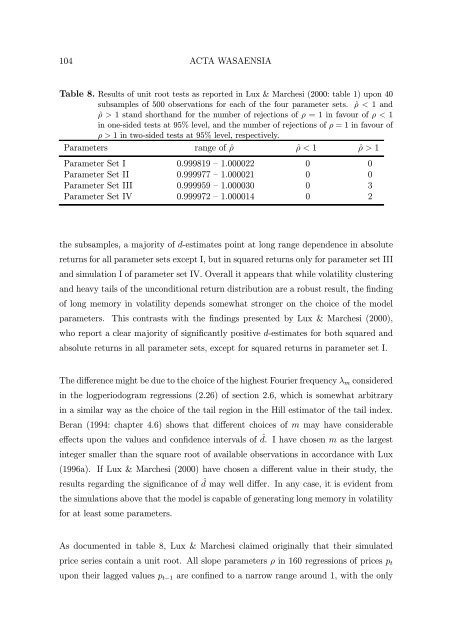BERND PAPE Asset Allocation, Multivariate Position Based Trading ...
BERND PAPE Asset Allocation, Multivariate Position Based Trading ...
BERND PAPE Asset Allocation, Multivariate Position Based Trading ...
Create successful ePaper yourself
Turn your PDF publications into a flip-book with our unique Google optimized e-Paper software.
104 ACTA WASAENSIATable 8. Results of unit root tests as reported in Lux & Marchesi (2000: table 1) upon 40subsamples of 500 observations for each of the four parameter sets. ˆρ < 1andˆρ > 1 stand shorthand for the number of rejections of ρ =1infavourofρ < 1in one-sided tests at 95% level, and the number of rejections of ρ =1infavourofρ > 1 in two-sided tests at 95% level, respectively.Parameters range of ˆρ ˆρ < 1 ˆρ > 1Parameter Set I 0.999819 — 1.000022 0 0Parameter Set II 0.999977 — 1.000021 0 0Parameter Set III 0.999959 — 1.000030 0 3Parameter Set IV 0.999972 — 1.000014 0 2the subsamples, a majority of d-estimates point at long range dependence in absolutereturns for all parameter sets except I, but in squared returns only for parameter set IIIand simulation I of parameter set IV. Overall it appears that while volatility clusteringand heavy tails of the unconditional return distribution are a robust result, the findingof long memory in volatility depends somewhat stronger on the choice of the modelparameters. This contrasts with the findings presented by Lux & Marchesi (2000),who report a clear majority of significantly positive d-estimates for both squared andabsolute returns in all parameter sets, except for squared returns in parameter set I.The difference might be due to the choice of the highest Fourier frequency λ m consideredin the logperiodogram regressions (2.26) of section 2.6, which is somewhat arbitraryin a similar way as the choice of the tail region in the Hill estimator of the tail index.Beran (1994: chapter 4.6) shows that different choices of m may have considerableeffects upon the values and confidence intervals of ˆd. I have chosen m as the largestinteger smaller than the square root of available observations in accordance with Lux(1996a). If Lux & Marchesi (2000) have chosen a different value in their study, theresults regarding the significance of ˆd may well differ. In any case, it is evident fromthe simulations above that the model is capable of generating long memory in volatilityforatleastsomeparameters.As documented in table 8, Lux & Marchesi claimed originally that their simulatedprice series contain a unit root. All slope parameters ρ in 160 regressions of prices p tupon their lagged values p t−1 are confined to a narrow range around 1, with the only
















